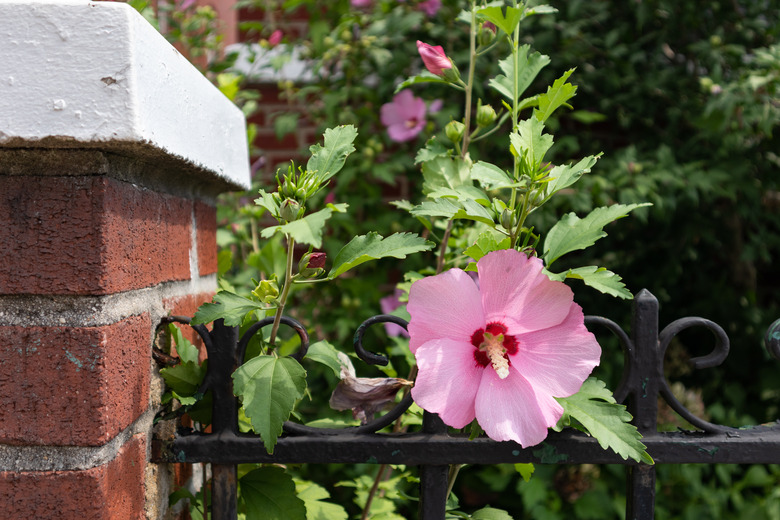Rose Of Sharon And Damage To A House's Foundation
We may receive a commission on purchases made from links.
The lovely rose of Sharon (Hibiscus syriacus, USDA zones 5-9) is a summer-blooming ornamental shrub that produces showy, colorful flowers from July through September. Its elegant vase-like habit and palmate gray-green leaves make the shrub a beautiful addition to the traditional romantic garden. While the young shrub develops as a beautiful compact bush, it grows rapidly and may overpower a foundation garden bed. Before worrying about a rose of Sharon and damage to a house's foundation, consider a few facts about this flowering shrub.
Rose of Sharon Growth Habit
Rose of Sharon Growth Habit
The rose of Sharon is a rapidly growing shrub, extending to an average height of 8 to 12 feet in a few years. In general, the rose of Sharon and most of its cultivars are too tall to use as foundation plants, as the shrub will overpower the other plants in the bed and conceal the house windows and architectural details unless you prune it regularly. When pruned into a single or multi-stemmed tree-form, you can take advantage of its rapid growth and height and still enjoy the flowers through the summer.
Despite the size of the original shrubs, there are dwarf cultivars better suited as foundation plantings, such as 'Lil' Kim,' which provides prolific white blossoms with red eyes. With a mature height around 50 inches and a spread generally half its height, 'Lil' Kim' should be planted 48 to 60 inches apart to allow for the spread of its branches and roots.
Rose of Sharon is not too picky about soil quality, but it does tolerate the alkaline soil commonly created by the limestone mortars of house foundations. The plant also propagates quickly, rapidly populating the foundation landscaping with suckers and numerous seedlings. Prune and deadhead regularly to remove the seeds and slow its invasive tendencies.
Root Damage to a Foundation
Root Damage to a Foundation
Technically, any shrub can damage a house's foundation. Roots seeking more space, water and nutrients may squirm their way into tiny weaknesses in the foundation wall. The rose of Sharon is a fast-growing and prolific plant, rapidly stretching out its roots to claim more territory for its own branches and its suckering offspring. Tiny underground roots may eventually poke into and permeate the mortar of older stone foundations pocked by years of rain and frost heave.
When given the choice, however, the shrub is more likely to extend into the adjoining soil than interfere with the foundation wall. Rose of Sharon prefers moist, well-draining soils, so if grown next to newer concrete or cinder block foundations, damage from the roots is unlikely unless there are leaking water or sewer pipes nearby.
Other Damage to a Foundation
Other Damage to a Foundation
Water is more hazardous to the foundation than burrowing roots. When fully established in close proximity to the house foundation, the rose of Sharon provides thick overgrowth, shading the foundation and retaining moisture below the ground.
Mildew, mold and fungus may latch on to the foundation, eroding the surface and allowing water to seep into small cracks. The water will freeze during the winter season, enlarging the cracks. In severe cases, the cracks may allow water to seep into the depths of the foundation walls, causing more damage. Larger rose of Sharon shrubs may also interfere with rainwater dispersal, clogging gutters with dead leaves in fall and winter and inhibiting proper roof drainage.
Planting Distance From the Foundation
Planting Distance From the Foundation
While the rose of Sharon in most cases will not damage a house's foundation, the threat of foundational damage remains because of the shrub's speedy root and branch growth, fertile reproduction and towering height. In general, a tall shrub like a Rose of Sharon is best planted in a shrub border or in a mass planting at least 4 to 5 feet away from the house foundation, where the plant can broaden its branches unhampered. A dwarf cultivar can be planted 2 to 4 feet from the foundation.
If the shrub currently is growing near a foundation, the dangers are slight, yet you would be wise to control its fast growth with annual pruning. Pruning provides better air circulation through the branches of a rose of Sharon shrub and staves off its wild, suckering habits. Alternatively, wait until late fall when the shrub goes dormant and transplant it to a new location, away from your foundation.
